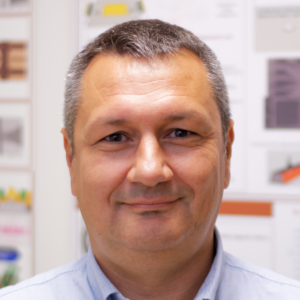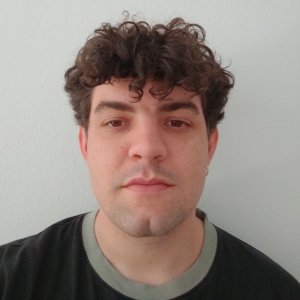Overview
The Magnetic Random Access Memories (MRAM) group develops advanced concepts in this emerging technology. The goal is to realize cells with improved thermal stability, lower power consumption and/or faster switching. Our research covers material stack deposition, nano-fabrication and electrical test evaluation, for applications as standalone memory and non-volatile logic and more recently in neuromorphic computing architectures.
Research directions
Perpendicular Anisotropy Materials
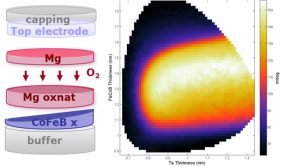
High energy barriers for spin transfer torque (STT) MRAM cells can be achieved with perpendicular anisotropy magnetic tunnel junctions. Solutions for high density MRAM cells to diameters below 20nm require continuous improvements in perpendicular surface anisotropy, while maintaining high TMR properties.
Perpendicular STT MRAM
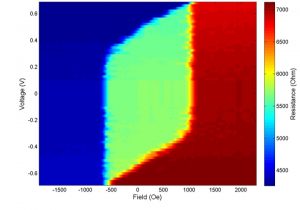
Evaluation of MRAM concepts requires simulation of expected reversal mechanisms and electrical characterization of individual cells. We aim at understanding dynamics of magnetization reversal and the expected impact of stack modifications to explore application specific optimizations.
Nanofabrication Challenges
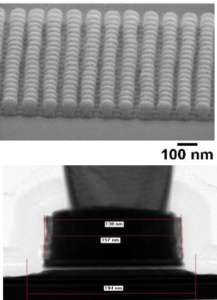
Innovation on dense MRAM using pre-patterned substrates, CMOS integration of multifunctional cells and sub-10nm lateral sizes. Tunnel junction nanofabrication in our platform is essential to evaluate MRAM concepts and performance.
Perpendicular Shape Anisotropy
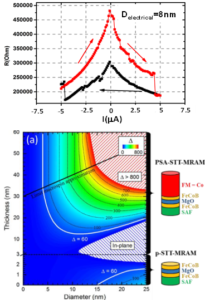
A solution for sub-10nm cell sizes uses high aspect ratios to generate perpendicular shape anisotropy providing scalable retention at the smallest cell sizes. Spin transfer torque switching is possible in these cells, where the reversal dynamics is now under study.
The team
Former members
Post-docs
- Andrey TIMOPHEEV (2014-2017)
- Van Dai NGUYEN (2016-2018)
- J. Ranier Roiz (2015-2016)
- Nikita Strelkov (2016-2019)
PhD
- Luc TILLIE (2015-2018)
- Nicolas PERRISSIN (2015-2018)
- Jyotirmoy CHATTERGEE (2014-2017)
- Hieu Tan NGUYEN (2013-2016)
- Antoine Chavent (2013-2015)
Process Engineers
- Jude GUELFFUCCI (2015-2017)
- Nathalie LAMARD (2016-2017)
- Guillaume LAVAITTE (2015-2016)
Projects
- Samsung SGMI (2014-2017)
- ANR Excalyb (2014-2017)
- Heumem (2015-2018)
- EU-FET Spice (2016-2019)
- EU Great (2016-2019)
- ERC Magical (2015-2020)
Partners
- CEA LETI, Grenoble, France
- Institut NEEL, Grenoble, France
- Crocus Technology, Grenoble, France
- Samsung, San Jose, USA
- Singulus AG, Kahl am Main, Germany
- Aarhus University, Aarhus, Denmark
- Radboud Universiteit, Neijmegen, Netherlands
Recent news
- Masters thesis projects for Spring 2021 (September 15th, 2020)

You find here the list of proposals for Master-2 internships to take place at Spintec during Spring 2021. In most cases, these internships are intended to be suitable for a longer-term PhD work. Interested Master-1 ... - Optical access of magnetic tunnel junctions for future hybrid spintronic–photonic memory circuits (August 24th, 2020)

We demonstrate in this study a fabrication process that enables the realization of a top transparent conductive electrode of magnetic tunnel junctions (MTJs), building blocks of magnetic random access memories (MRAMs). This work opens up ... - Review — Opportunities and challenges for spintronics in the microelectronics industry (August 19th, 2020)

The European consortium SpintronicFactory, largely supported by the French laboratories Spintec (Grenoble) and the CNRS-Thales Joint Lab (Palaiseau), publishes in the journal Nature Electronics an ambitious roadmap for spintronics. This discipline on the borderline between ... - Kevin GARELLO joins SPINTEC (June 05th, 2020)

We are pleased to announce the arrival on June 2, 2020 of Kevin Garello at SPINTEC. Kevin comes from IMEC Belgium, where he was in charge of exploratory magnetic memory activities, being in addition the ... - All-optical switching of magnetization in Tb/Co-multilayer based electrodes (April 30th, 2020)

This work reports the development of perpendicular magnetic tunnel junctions incorporating a stack of Tb/Co nanolayers whose magnetization can be all-optically controlled via helicity-independent single-shot switching. Toggling of the magnetization of the Tb/Co electrode was ...







